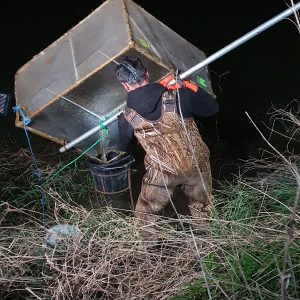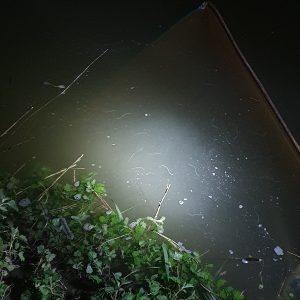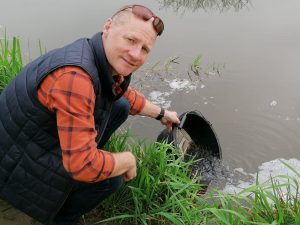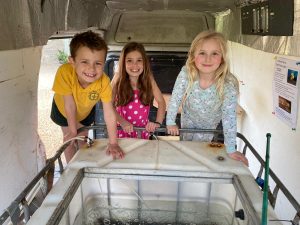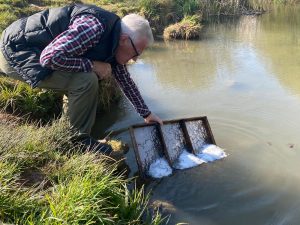Moments after releasing 145,000 elvers at Bradford-on-Tone, they are seen migrating upriver.
16 April 2021. With the help of volunteer fishermen, traders, local land owners, the Environment Agency and the Sustainable Eel Group, elvers (baby eels) have been caught on the rivers Parrett and Yeo and moved over eight barriers to their upstream migration in different rivers on the Somerset Moors and Levels. This will help them migrate to find new homes in the rivers and wetlands upstream.

The elvers are caught sustainably in a hand-net at night within sight of Burrow Mump, on the Somerset Levels
Commercial fishing for elvers is suspended this year due to trade changes caused by Brexit. So fishing this year is for volunteers to donate for conservation in local rivers. These donations help the elvers over barriers to migration they might not have got over, where they can make best use of the rivers and wetlands to produce as many adults as possible to return for spawning.
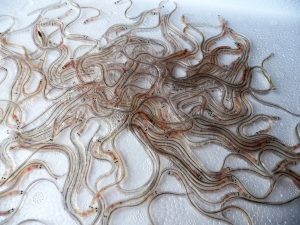
The elvers, baby eels, also known as ‘Glass eels’ due to their transparency at this stage in their life cycle.
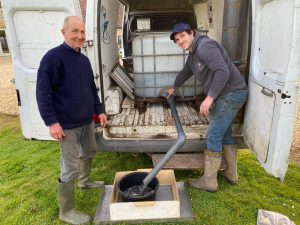
The eels were collected from the fishermen and released with the help of eel traders Peter and Max Neusinger of Eeline UK Ltd.
One million barriers across rivers in Europe mean that the eel can only access 10% of the habitats it used to. Whilst still common and widespread, the eel was once super abundant. Total numbers of the eel have reduced by 90 – 95% compared to only 40 years ago, though numbers have stabilised with some signs of recovery, since 2011.
The Somerset rivers and wetlands are an ideal habitat for eels. They will grow there, play their full role within the ecosystem, and then make their return migration to the Sargasso Sea near Bermuda to spawn and breed about 15 years later.
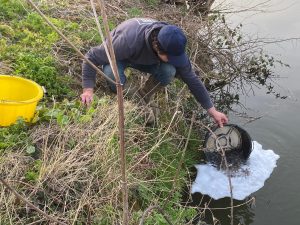
24,000 elvers are released to the River Cary, upstream of Henley sluice which is impassable to their natural migration.
Andrew Kerr of the Sustainable Eel Group said: “It is great that elver fishermen are volunteering to catch and donate fish to re-wild local wetlands – leaving the fish the wrong side of the barriers is a waste of a precious natural resource. It is time the UK had a rewilding programme for eel to complement the programme of un-blocking migration pathways”.
Eels are an important part of the water environment. They feed on dead and decaying animals – helping to recycle nutrients. They are also important food for otters and birds such as herons, egrets and bitterns.
European eels have an extraordinary life cycle. They start as eggs in the Sargasso Sea near Bermuda and spend about two years floating on ocean currents towards the coasts of Europe and North Africa. They enter rivers and lakes and can a take several decades to grow up and mature. They then return to sea and swim 3000 miles for over a year back to spawn in the Sargasso Sea.
The rewilding programme moves to the Severn in Gloucestershire, starting with the big tides on the 27th and 28th of April.
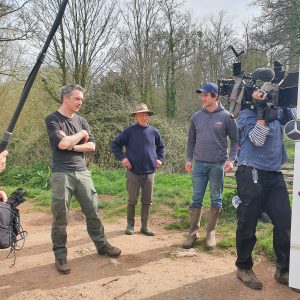
This story will be featured on the BBC’s Countryfile programme on Sunday 18 April. Presenter Joe Crowley is on the left. It can be viewed here.
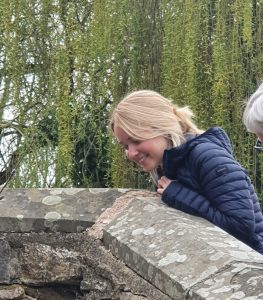
Local singer-songrwiter Kitty MacFarlane watches the elver release at Bradford-on-Tone.
Kitty has written and recorded a song especially about the Glass eel. It can be viewed here.

